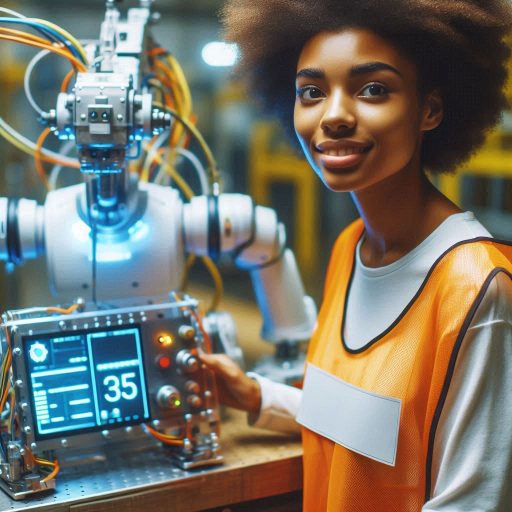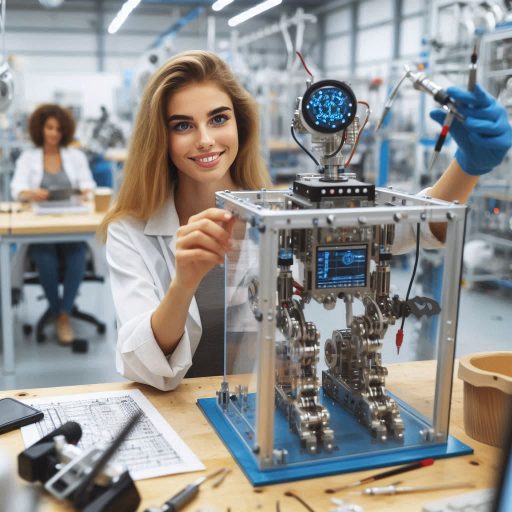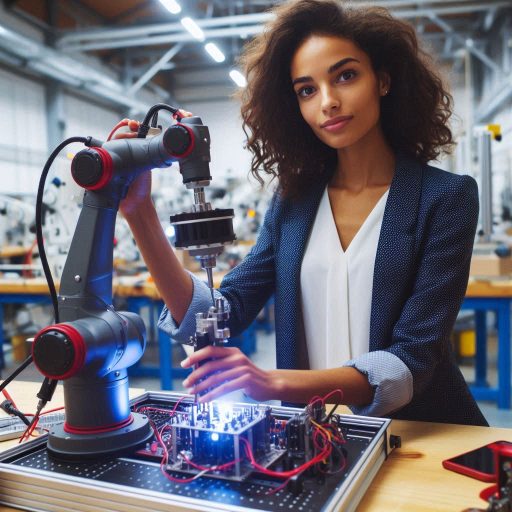Introduction
Robotics Engineering in Space Exploration
Robotics engineering is essential to advancing space exploration.
This field involves designing and developing robots that can operate in the harsh and unpredictable conditions of space.
These robots are critical for performing tasks that would be too dangerous or complex for human astronauts.
They are designed to handle everything from simple maintenance tasks to complex scientific experiments.
Importance of Robotics
The role of robots in space exploration cannot be overstated.
They are instrumental in conducting experiments and managing equipment repairs on missions.
By handling these tasks, robots minimize the risks to astronauts, allowing them to focus on other essential aspects of the mission.
Furthermore, robots extend the reach of exploration by traveling to distant planets and moons, collecting data from environments that are otherwise inaccessible.
Their ability to operate autonomously and efficiently enhances mission outcomes and extends the duration of space operations.
Robotics engineering thus drives innovation in space technology, pushing the boundaries of what is possible and expanding our knowledge of the universe.
History of Robotics in Space Exploration: A New Frontier
Early Robotic Missions to Space
Robotics has played a crucial role in space exploration since the early days.
Early robotic missions laid the groundwork for future advancements.
- Sputnik 1 (1957): The Soviet Union launched Sputnik 1, the first artificial satellite.
It marked the beginning of space robotics, though not yet equipped with advanced technology. - Lunar Probes (1960s): The Soviet Luna series and NASA’s Ranger missions were early attempts to explore the Moon.
These spacecraft gathered valuable data, paving the way for manned missions. - Mariner Series (1960s-1970s): NASA’s Mariner probes explored Mars and Venus.
These missions provided crucial information about the planets’ atmospheres and surfaces. - Viking Landers (1976): Viking 1 and Viking 2 were the first spacecraft to land on Mars.
They conducted experiments and sent back detailed images of the Martian surface.
Evolution of Robotics Technology in Space Exploration
Robotic technology has advanced significantly, enhancing our ability to explore space.
The evolution of robotics in space exploration has revolutionized how we study celestial bodies.
- Robotic Arms and Rovers (1980s-1990s): Robotic arms, like those on the Space Shuttle, performed maintenance tasks in orbit.
Mars rovers, such as Sojourner (1997), began to explore the Martian surface autonomously. - International Space Station (1998-present): The ISS has become a hub for robotic research.
The Canadarm2, a sophisticated robotic arm, assists with station maintenance and cargo handling. - Advanced Rovers and Landers (2000s-present): Rovers like Spirit, Opportunity, and Curiosity have provided detailed analyses of Mars.
They have conducted experiments and searched for signs of past life. - Exploration of Outer Planets (2010s-present): Robotic missions like Juno and New Horizons have explored Jupiter and Pluto.
These missions provide insights into the outer reaches of our solar system. - Robotic Spacecraft for Asteroids (2010s-present): Missions like OSIRIS-REx and Hayabusa2 have studied asteroids.
They collect samples and help us understand the early solar system.
Key Developments
- Increased Autonomy: Modern robots operate with high autonomy, allowing them to perform complex tasks with minimal human intervention.
- Improved Mobility: Advanced rovers and landers can navigate challenging terrain, extending their operational capabilities.
- Enhanced Communication: Better communication systems allow for real-time data transmission, improving mission success rates.
- Precision Instruments: New robotic missions use highly precise instruments for detailed scientific analysis.
In essence, the history of robotics in space exploration highlights a remarkable journey from early missions to sophisticated, autonomous systems.
These technological advancements have significantly expanded our understanding of space.
As we continue to push the boundaries of exploration, robotics will remain at the forefront of discovering new frontiers.
Even greater achievements in our quest to explore and comprehend the universe.
Robotics will undoubtedly remain at the forefront of space exploration, leading us to new frontiers and expanding our knowledge of the cosmos.
Read: How to Build a Strong CAD Technician Portfolio
Role of Robotics in Current Space Missions
Robotics play a crucial role in current space missions.
They enhance exploration capabilities, perform intricate tasks, and gather vital data.
Here‘s a look at some examples of robotic spacecraft and rovers, and the tasks they perform in space missions.
Examples of Robotic Spacecraft and Rovers
Mars Rovers
- Curiosity Rover: Launched in 2011, Curiosity explores Mars’ surface, analyzing soil, rock, and atmosphere.
- Perseverance Rover: Landed in 2021, Perseverance searches for signs of ancient life and collects samples for future return missions.
Voyager Probes
Voyager 1 and 2 Launched in 1977, these probes explore the outer solar system and interstellar space, sending back valuable data.
Juno Spacecraft
Juno Orbiting Jupiter since 2016, Juno studies the planet’s atmosphere, magnetic field, and structure.
New Horizons
New Horizons After its 2006 launch, it conducted a flyby of Pluto in 2015 and continues exploring the Kuiper Belt.
Tasks Performed by Robotic Systems in Space Missions
Surface Exploration
- Soil Analysis: Rovers like Curiosity perform detailed chemical and mineral analysis of Martian soil and rocks.
- Sample Collection: Perseverance collects rock and soil samples, which may be returned to Earth by future missions.
Data Collection and Transmission
- Environmental Monitoring: Spacecraft collect data on planetary atmospheres, magnetic fields, and weather conditions.
- Long-Distance Communication: Probes like Voyager transmit data over vast distances, providing insights into the outer reaches of the solar system.
Mission Operations
- Autonomous Navigation: Rovers navigate the planetary surface using onboard cameras and sensors, avoiding obstacles and choosing paths.
- Scientific Experiments: Spacecraft conduct experiments in space environments that are otherwise inaccessible to human crews.
Surface Interaction
- Sample Analysis: Instruments onboard rovers analyze samples on-site, performing tasks like drilling, imaging, and spectrometry.
- Environmental Sampling: Robots measure atmospheric composition and detect radiation levels.
They help us understand extraterrestrial environments better.
Remote Exploration
- Planetary Imaging: Spacecraft capture high-resolution images of celestial bodies, aiding in geological and environmental studies.
- Orbital Mapping: Robotic systems create detailed maps of planetary surfaces, which are critical for selecting landing sites and planning future missions.
In general, robotics are indispensable in modern space missions.
They extend human capabilities, perform complex tasks, and provide invaluable data that shape our understanding of the universe.
As technology advances, robots will continue to push the boundaries of space exploration.
Read: Best Online Courses for CAD Technician Training
Advantages of Using Robotics in Space Exploration
Space exploration presents numerous challenges, making robotics a crucial component in advancing our capabilities.
Robotics in space exploration offers distinct advantages, particularly in enduring harsh environments and providing cost-effective solutions compared to human missions.
Withstanding Harsh Space Environments
- Extreme Temperatures: Robots can endure extreme temperatures that would be harmful or fatal to humans.
They can operate in the frigid conditions of outer space or the intense heat of planetary surfaces without the need for complex life support systems. - Radiation Exposure: Space robots are designed to withstand high levels of radiation.
Unlike humans, robots do not suffer from radiation-induced health issues, making them ideal for prolonged missions in high-radiation environments. - Zero Gravity: Robots are engineered to function in zero-gravity conditions.
They can perform tasks and conduct experiments without the constraints imposed on human bodies by microgravity, such as muscle atrophy and bone loss. - Remote Operation: Scientists can control robots remotely from Earth.
This setup lets them explore distant planets and moons without physical presence.
This remote operation capability is crucial for missions far from our planet.
Cost-Effectiveness Compared to Human Space Missions
- Reduced Life Support Costs: Human space missions require extensive life support systems, including food, water, oxygen, and waste management.
Robots eliminate these costs, making missions more affordable. - Lower Risk and Insurance Costs: Robotic missions pose no risk to human life, reducing the need for expensive insurance and safety measures associated with manned missions.
This significantly lowers overall mission costs. - Extended Mission Durations: Robots can operate continuously without the physical and psychological limitations faced by humans.
This allows for longer missions and more extensive exploration without the need for costly resupply missions. - Minimized Training Requirements: Training astronauts for space missions is an expensive and time-consuming process.
Robots require no such training, reducing the costs associated with human preparation and readiness. - High Reliability: Robotics technology has advanced to the point where robots can perform complex tasks with high reliability.
This reliability reduces the chances of mission failure, leading to cost savings and more successful missions. - Scalability: Robotics allow for scalable exploration strategies.
Multiple robots can be deployed simultaneously to cover various locations and collect diverse data, enhancing mission efficiency and effectiveness.
Generally, robotics play a pivotal role in space exploration by addressing the harsh conditions of space and offering a cost-effective alternative to human missions.
Their ability to withstand extreme environments and their cost-saving benefits make them indispensable in pushing the boundaries of our space exploration capabilities.
Read: Top Companies Hiring CAD Technicians in the USA
Challenges Faced by Robotics in Space Exploration
Robotics engineering is essential for advancing space exploration.
However, this field faces significant challenges that impact the effectiveness and reliability of robotic systems.
Among these challenges, communication delays and maintenance difficulties are particularly critical.
Communication Delays and Limitations
Space exploration involves operating over vast distances, which introduces notable communication delays.
These delays can affect how effectively robots operate and how quickly data is transmitted back to Earth.
- Signal Travel Time: The finite speed of light limits the speed of signal transmission.
For instance, sending a signal to Mars can take approximately 13 minutes one-way.
This delay means that operators on Earth must wait a significant time before receiving feedback from robotic systems on Mars. - Real-Time Commands: Due to the delay, sending real-time commands to robots becomes impractical.
Operators cannot control robots in real-time; instead, they must rely on pre-programmed instructions.
This requires careful planning and anticipation of the robot‘s needs and tasks. - Data Transmission: The transmission of large volumes of data from space to Earth is a slow process.
High-resolution images, scientific data, and other information must be compressed and transmitted over long distances, which can take additional time.
This delay impacts how quickly scientists can analyze and respond to the data. - Limited Communication Windows: Communication windows can be limited by the positions of Earth and the spacecraft.
When spacecraft are on the far side of celestial bodies or out of the line of sight, communication can be interrupted.
This variability complicates mission planning and coordination.
Maintenance and Repair Difficulties in Space
Maintaining and repairing robots in space is a complex and challenging task.
The space environment and the distance from Earth introduce unique difficulties.
- Limited Access: Space robots are often located in hard-to-reach areas.
For example, robots on the surface of distant planets or moons may be inaccessible to astronauts or maintenance teams.
This limited access means that repairs must be done remotely or autonomously, which poses significant challenges. - Harsh Environment: The space environment presents extreme conditions, such as high radiation, vacuum, and temperature fluctuations.
These conditions can cause wear and tear on robotic systems, affecting their functionality over time.
Engineers must design robots to withstand these harsh environments. - Spare Parts: Sending spare parts to space is expensive and logistically complex.
Carrying a full set of replacement parts for every possible issue is impractical.
Therefore, robotic systems must be designed for durability and redundancy to minimize the need for repairs. - Autonomous Repairs: To address maintenance issues, robots may need to perform self-diagnostics and repairs.
Developing autonomous repair capabilities is challenging but crucial.
Robots must be able to detect faults, perform necessary repairs, and continue their missions without human intervention. - Resource Management: Space missions often have limited resources.
Managing these resources efficiently while ensuring that robots can perform necessary repairs is a key challenge.
This includes managing energy supplies, onboard tools, and repair materials.
Basically, communication delays and maintenance difficulties are significant hurdles in robotics engineering for space exploration.
Addressing these challenges requires innovative solutions, such as improved communication technologies and resilient robot designs.
Enhance communication strategies and develop advanced autonomous repair systems to push the boundaries of space exploration in robotics.
Overcoming these challenges will be essential for the success of future missions and for expanding our understanding of the universe.
Read: Future of CAD Technician Jobs in Engineering
Transform Your Career Today
Unlock a personalized career strategy that drives real results. Get tailored advice and a roadmap designed just for you.
Start Now
Future of Robotics in Space Exploration
The future of robotics in space exploration is promising. Robotics engineers are developing advanced autonomous systems.
These systems will perform critical tasks in space missions.
They will operate without direct human control.
This development enhances efficiency and safety during missions.
Development of Autonomous Robotic Systems
Autonomous robotic systems are becoming more sophisticated.
They are designed to handle complex tasks independently.
These systems can:
- Navigate Harsh Environments: They can move and operate in challenging space conditions.
- Conduct Repairs: They will perform maintenance on spacecraft and space stations.
- Gather Data: They will collect and analyze scientific data from distant celestial bodies.
These robots use artificial intelligence to make real-time decisions.
They adapt to unexpected situations, ensuring mission success.
Future advancements aim to improve their problem-solving capabilities.
The goal is to have robots that can work seamlessly in unpredictable environments.
Potential for Human-Robot Collaboration
Human-robot collaboration is another exciting frontier.
Combining human skills with robotic precision offers several advantages.
This collaboration can:
- Enhance Mission Efficiency: Robots can handle repetitive or dangerous tasks, allowing humans to focus on complex problem-solving.
- Improve Safety: Robots can perform tasks in hazardous conditions, reducing risks for astronauts.
- Extend Exploration Capabilities: Collaborative robots can help humans explore more remote or challenging areas of space.
Astronauts will work alongside robots to achieve mission objectives.
Robots will assist in conducting experiments, assembling structures, and even managing spacecraft systems.
This partnership will enhance the scope and success of space missions.
Future Prospects and Challenges
The future of robotics in space exploration holds significant promise.
Advanced robotics will play a crucial role in extending human presence in space.
However, challenges remain, including:
- Technical Limitations: Developing robots that can function reliably in space’s harsh environment is challenging.
- Integration Issues: Ensuring smooth interaction between humans and robots requires careful planning and testing.
- Cost: High development and deployment costs need to be managed to make space exploration more accessible.
Addressing these challenges is essential for advancing space exploration.
Robotics will continue to push the boundaries of what is possible in space.
The future of robotics in space exploration is bright.
Autonomous systems and human-robot collaboration will drive innovation.
As technology evolves, robots will become indispensable in exploring and understanding the cosmos.
The integration of these systems will open new frontiers in space exploration, making ambitious missions more achievable and successful.
Impact of Robotics on Space Exploration Technology
Robotics engineering has revolutionized space exploration, making unprecedented advancements in technology.
This impact is significant in two main areas: innovation and future strategies.
Innovation in Robotics Engineering Advancements
Robotic technology has introduced groundbreaking innovations in space exploration:
- Autonomous Systems: Modern robots operate autonomously in harsh space environments.
They perform tasks without human intervention, increasing efficiency and safety. - Advanced Sensors and AI: Robots now feature sophisticated sensors and artificial intelligence.
These technologies allow for real-time data analysis and decision-making. - Enhanced Mobility: Robotic designs include improved mobility systems.
These systems enable robots to navigate complex terrains on other planets and moons. - Precision and Dexterity: Robotic arms and tools offer high precision.
They handle delicate tasks, such as assembling space structures or conducting scientific experiments. - Durability and Resilience: New materials and designs enhance robot durability.
They withstand extreme temperatures and radiation in space.
Influence on Future Space Exploration Strategies
The advancements in robotics engineering are shaping future space exploration strategies:
- Cost Reduction: Robotics reduces the need for human presence in space.
This lowers mission costs and allows for more frequent launches. - Extended Missions: Robots can operate in space for extended periods.
They conduct long-term studies and maintain equipment, expanding mission duration and scope. - Planetary Exploration: Robotics enables detailed exploration of planetary surfaces.
Robotic rovers gather valuable data and samples from remote or hazardous locations. - Space Construction: Robotic systems assist in building and repairing space structures.
They are essential for constructing habitats and satellites in orbit. - Human-Robot Collaboration: Future missions will involve close collaboration between humans and robots.
This synergy will enhance mission success and safety.
In the ending, robotics engineering is transforming space exploration with significant advancements and strategic impacts.
Innovations in autonomous systems, sensors, mobility, precision, and durability drive progress.
These technologies influence cost reduction, mission extension, planetary exploration, space construction, and human-robot collaboration.
As robotics continues to evolve, it will play a crucial role in expanding humanity‘s reach into space.
Uncover the Details: Emerging Trends in Industrial Engineering
Ethical Considerations in Robotics Engineering for Space Exploration
Robotics engineering plays a pivotal role in space exploration.
As technology advances, ethical considerations become crucial.
These considerations encompass the implications of AI and autonomous robots and the ethical responsibilities associated with their use in space missions.
Implications of AI and Autonomous Robots in Space
Artificial Intelligence (AI) and autonomous robots are revolutionizing space exploration.
Their ability to operate independently from human control is invaluable.
However, this autonomy raises several ethical concerns:
- Decision-Making Autonomy: AI systems must make decisions without human input.
This autonomy can lead to unintended consequences.
Ethical guidelines must govern how these decisions are made to ensure they align with human values. - Accountability: Determining responsibility for actions taken by autonomous robots is challenging.
If a robot makes a mistake, it‘s essential to identify who is accountable‘the developers, operators, or the AI itself. - Mission Integrity: Autonomous robots could potentially alter mission objectives or protocols.
Ensuring these robots adhere to predefined guidelines and mission goals is crucial to maintain mission integrity. - Security Risks: Autonomous robots can be vulnerable to hacking or manipulation.
Ensuring robust security measures is necessary to protect sensitive space missions from potential threats.
Ethical Responsibilities of Utilizing Robots in Space Missions
Utilizing robots in space missions involves several ethical responsibilities.
These responsibilities address both the design and deployment of these technologies:
- Safety: Ensuring the safety of both the robots and any human astronauts is paramount.
Robots must be designed to operate safely in complex space environments and handle unforeseen situations without causing harm. - Environmental Impact: Space missions should minimize the environmental impact on celestial bodies.
Ethical design practices should focus on preventing contamination and preserving the integrity of extraterrestrial environments. - Data Privacy: Robots collect vast amounts of data during missions.
Handling this data responsibly, including protecting sensitive information and respecting privacy, is essential. - Equitable Access: Ensuring that robotic technology benefits all of humanity is an ethical obligation.
This involves making advancements in space robotics accessible to a diverse range of researchers and countries. - Informed Consent: When collaborating with international partners or private entities, secure informed consent for using robotic technologies.
Transparency in how robots are used and their objectives fosters trust and cooperation.
In summary, as robotics engineering propels space exploration into new frontiers, addressing ethical considerations becomes increasingly important.
Ensuring responsible use of AI and autonomous robots and adhering to ethical guidelines helps safeguard the integrity and success of space missions.
Balancing technological advancement with ethical responsibility is essential for the future of space exploration.
Conclusion
Robotics engineering is pivotal in expanding space exploration capabilities.
Robots allow us to explore distant planets and moons that are beyond human reach.
Their ability to operate in harsh environments and perform complex tasks enhances mission efficiency and reduces both risks and costs.
By collecting valuable data, robots contribute significantly to our understanding of space, facilitating scientific breakthroughs and technological advancements.
The importance of continued research and innovation in robotics cannot be overstated.
Investing in new projects that challenge current technological limits is crucial for advancing our space exploration capabilities.
Collaboration between space agencies, research institutions, and private companies is essential to drive progress.
Such partnerships leverage diverse expertise and resources, fostering groundbreaking developments in robotics technology.
Embracing emerging technologies and novel ideas will further enhance the capabilities of robotic missions.
As we push the boundaries of what is possible, we unlock new opportunities for exploring the cosmos.
Advancing robotics engineering paves the way for future discoveries and innovations.
We shape space exploration‘s future and expand our understanding of the universe.
[E-Books for Sale]
The Big Book of 500 High-Paying Jobs in America: Unlock Your Earning Potential
$19.99 • 500 High-Paying Jobs • 330 pages
Explore 500 high-paying jobs in America and learn how to boost your career, earn more, and achieve success!
See All 500 High-Paying Jobs of this E-Book
1001 Professions Without a Degree: High-Paying American Jobs You Can Start Now
$19.99 • 1001 Professions Without a Degree • 174 pages
Discover 1001 high-paying jobs without a degree! Unlock career tips, skills, and success strategies for just $19.99!




